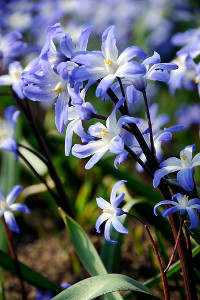January: a challenge met
The Winter Aconite (Eranthis) and Snowdrop (Galanthus) are the first flower bulbs to meet the challenge of January’s icy weather. These brave little plants will even push their way through the snow to display their flowers. Subtle white snowdrops and bright yellow winter aconites have to be the real harbingers of spring.


February: more flower bulbs emerge
In February, the number of different spring-flowering bulbs showing their faces quickly rises. This is the month when several kinds see it as time to emerge from their winter slumber. Crocuses (Crocus), dwarf irises (Iris reticulata) and spring snowflakes (Leucojum vernum) are adding sparkle to the garden together with the Striped Squill (Puschkinia) and Glory-of-the-Snow (Chionodoxa).


March: a burst of colour
March is the month when the garden enjoys a real burst of colour. That’s when colourful flower bulbs like anemones (Anemone), cyclamens (Cyclamen), grape hyacinths (Muscari), daffodils (Narcissus), the Nodding Star-of-Bethlehem (Ornithogalum nutans) and the Siberian Squill (Scilla siberica) appear and greet us. This is the month when the garden fills with the delightful scent of grape hyacinths – a scent that also has an irresistible attraction for bees.


April: when tulips reign supreme
In April, you can enjoy the most popular flower bulb of all: the Tulip (Tulipa). You’ll see them flashing their spectacular colours and unusual shapes wherever you look. The tulip is also joined in April by hyacinths (Hyacinthus), star flowers (Ipheion) and summer snowflakes (Leucojum aestivum). Meanwhile, the perennials are also starting to grow: a wonderful combination with the flower bulbs.


May: bulbs are still adorning the garden
Summer is already in sight, but the last spring-flowering flower bulbs are still adding a touch of elegance to the garden in May. Ornamental onions (Allium), Spanish bluebells (Hyacinthoides), Lilies-of-the Valley (Convallaria), Ixia and Ranunculus conclude the colourful spring bulb season.


Planting bulbs in four steps
- Rake the soil to loosen it a little.
- Dig a hole in the ground that is about three times as deep as the thickness of the bulb/corm/tuber.
- Arrange the flower bulbs in the hole with the ‘nose’ pointing upward and the ‘beard’ pointing downward.
- Cover the flower bulbs with soil.
Tips
- You can also create a larger planting hole – or bed – so that you can plant a larger number of flower bulbs together.
- The best time of year to plant flower bulbs is during the months of September, October, November and December (before freezing weather).
